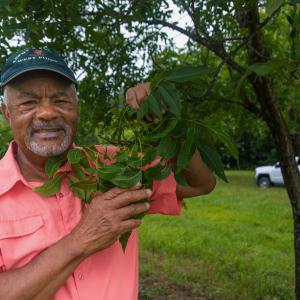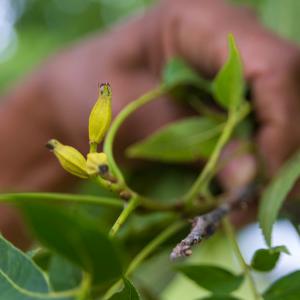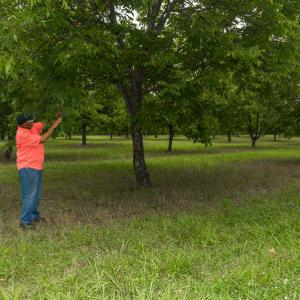Orchard Impossible
Extension resources help pecan grower’s orchard restoration
Story by Nathan Gregory • Photos by Kevin Hudson
Many Clay Countians know Art Sanders as the man who brought an abandoned pecan orchard back to life.
It was not until after he signed the deed on the 46-acre parcel 5 miles south of West Point in 1999 that Sanders learned what he had acquired. Aerial property photos revealed rows of trees, showing the previous owner had planned the orchard and planted pecan trees there in the mid-1980s—even augmenting it with an irrigation system and a well—before walking away from it.
“I didn’t realize it was a pecan orchard because there were so many other cedars and pines everywhere,” Sanders recalls. “I had no notion of being a pecan farmer at all. I just wanted to have some land to give me a purpose after I retired.”
Upon moving back to his home state in 2013 after a 30-plus year career as a Chicago, Illinois, firefighter—he grew up on a sharecropping farm in the Mississippi Delta—Sanders went right back to work. Only this time, he was clearing land, ripping up bad trees, and nursing the surviving ones to health until they began to bear fruit.
The orchard—nearly 800 trees—is now the official home of Lindy’s Pecans, named after Sanders’s wife, and boasts 10 pecan varieties, including Desirable, Pawnee, and Lakota.
“I’m like a one-man show here,” Sanders says. “My wife helps me during harvest time, but other than that, I do all my spraying, bushhogging, and putting fertilizer down.”
Along the way, he has used a variety of resources offered by the Mississippi State University Extension Service to his benefit—and he still does. He’s a regular attendee of Extension’s field day events, and he often uses the MSU Extension soil testing lab, which provides analyses and nutrient management recommendations for different soils and plant tissues.
“I go out to the orchard, collect soil samples, and have my county Extension agent take it to the soil testing lab instead of trying to guess what type of fertilizer or chemical I might need,” he says. “The sample tells you how much pH is in the soil. When it comes to pecans, they need a pH of about 6 to 6.5, and when I started getting dirt samples, mine started off at a 3.”
Then, he turned to one of MSU Extension’s most important resources of all—its people. For horticultural guidance, he consults Dr. Jeff Wilson. Weed scientist= Dr. John Byrd is Sanders’s first phone call when he sees weeds that cause him concern. When he has an insect problem, he goes to entomologist Dr. Blake Layton, who retired in June.
Sanders says the lab results he got back from his first soil tests suggested he put down 2 tons of lime per acre—an amount he wasn’t expecting to hear.
“Dr. Wilson suggested putting down 1 ton a year and taking a gradual approach instead of trying to do it all at one time,” Sanders explains. “Last year, my soil pH got up to 6.1, and I was very happy.”
For insight on diseases, Sanders calls Extension plantpathologist Dr. Rebecca Melanson.
“Mr. Sanders is always enthusiastic when talking about his pecan orchard,” Melanson said. “He seeks every opportunity possible to learn more about pecan production and pest management in order to be successful in his endeavors, and he reaches out to our Extension specialists when he has questions so that he can gain the knowledge needed to make informed decisions.”
Before drought and an ill-timed freeze halted the streak in 2023, Sanders’s total yield increased each year for 6 consecutive years, a feat that still brings him satisfaction.
“To be a pecan grower, it’s altogether a different game from when I was throwing a stick in a pecan tree in Vance and Tutwiler as a kid,” he says. “I’ve gotten so far into it now that I can’t get out. I’m sitting here, going on 71 years old, and still enjoying this.”






